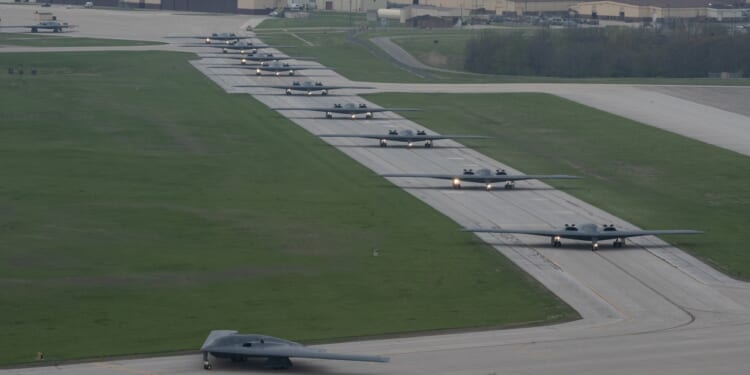Air Force General Anthony J. Cotton recently said he wanted a 220-aircraft bomber fleet. This would mean ordering 140 B-21 Raider stealth bombers, up from 100.
The U.S. Air Force maintains the largest and most advanced strategic bomber fleet in the world.
But, as is common in military matters, the Air Force needs to update its fleet, retiring some types of bombers and adding exciting new ones. How many strategic bombers does the Air Force want to have in the future? And are there any particular weapon systems that would further increase the lethality of the fleet?
STRATCOM Commander: America Needs 220 Strategic Bombers
Recently, Air Force General Anthony J. Cotton, the commander of U.S. Strategic Command (STRATCOM), shared his views about the ideal size of the future U.S. strategic bomber fleet. The four-star general said he ideally wants a 220-aircraft fleet in order to deal with near-peer and other threats on a global scale.
To get there, the Air Force would need to buy 145 B-21 Raider stealth strategic bombers, and not 100, its present order size.
The Air Force currently flies approximately 140 strategic bombers of three different types: the B-1 Lancer (speed), the B-2 Spirit (stealth), and the B-52 Stratofortress (capacity).
The Air Force plans to retire the B-1 Lancer and B-2 Spirit sometime in the next few years as the B-21 comes online. There are around 64 bombers of both types in service. Moreover, the Air Force operates approximately 76 B-52 Stratofortress bombers. The service intends to keep those aircraft in the active fleet with structural and technological updates—the “J” model—to ensure that the Stratofortress, first introduced in the 1950s, can fly well into the 21st century.
So, with 145 B-21 Raiders and 76 B-52 Stratofortresses, the Air Force would be adding 80 strategic bombers net total under the new proposed structure. It would also have a good balance between stealth and conventional options.
This is not the first time the STRACOM boss has indicated a desire for more B-21 Raiders. Last year, he told Congress that he wanted more B-21s, but without providing a specific number. Cotton’s statements might move the Pentagon and lawmakers to approve additional B-21s. However, the final cost per unit will also play a big role in the ultimate decision.
The B-21 Raider’s Production Woes
“I, as a customer, want to see increased rates [of B-21 Raider production],” Cotton said during the McAleese and Associates annual Defense Programs Conference.
The Air Force four-star said that he would like to see Northrop Grumman improve the current low production rate of the sixth-generation stealth bomber. As of now, Northrup Grumman’s factory for the B-21 Raider can produce around 21 aircraft in five production lots. To achieve 145, or even 100, B-21 Raiders, production must pick up the pace.
However, the Air Force and Congress are also quite wary of costs. For example, the Air Force initially planned on purchasing over 100 B-2 Spirits back in the 1990s. However, after the Soviet Union collapsed and the Cold War ended, the Air Force dramatically dialed back its order—only purchasing 21 aircraft, even though the production line was built for the initial goal. As a result of this change, each B-2 ended up costing almost $2 billion per aircraft. The Air Force seeks to avoid a similar situation with the construction of the B-21.
About the Author: Stavros Atlamazoglou
Stavros Atlamazoglou is a seasoned defense journalist specializing in special operations and a Hellenic Army veteran (national service with the 575th Marine Battalion and Army HQ). He holds a BA from the Johns Hopkins University and an MA from the Johns Hopkins’ School of Advanced International Studies (SAIS). His work has been featured in Business Insider, Sandboxx, and SOFREP.
Image: Wikimedia Commons.















